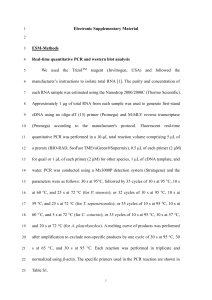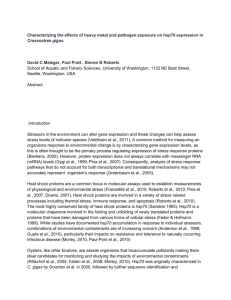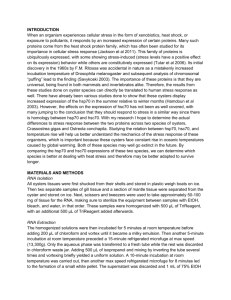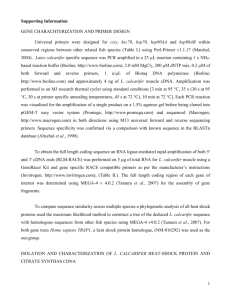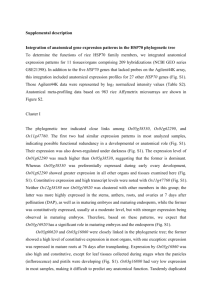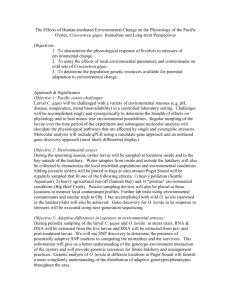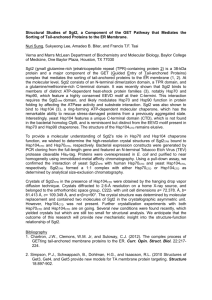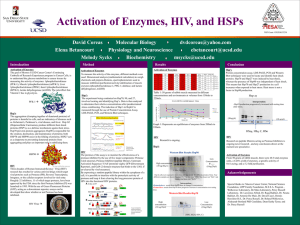Cgigas Cu hsp70 draft3 189KB Nov 09 2011 05:41
advertisement
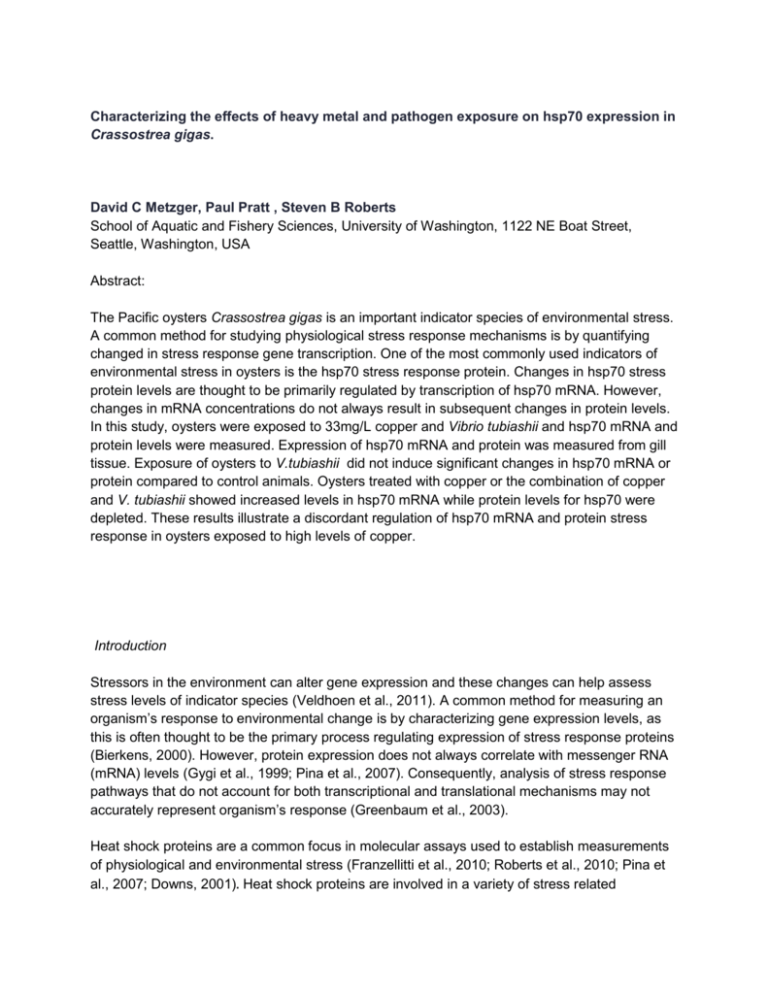
Characterizing the effects of heavy metal and pathogen exposure on hsp70 expression in Crassostrea gigas. David C Metzger, Paul Pratt , Steven B Roberts School of Aquatic and Fishery Sciences, University of Washington, 1122 NE Boat Street, Seattle, Washington, USA Abstract: The Pacific oysters Crassostrea gigas is an important indicator species of environmental stress. A common method for studying physiological stress response mechanisms is by quantifying changed in stress response gene transcription. One of the most commonly used indicators of environmental stress in oysters is the hsp70 stress response protein. Changes in hsp70 stress protein levels are thought to be primarily regulated by transcription of hsp70 mRNA. However, changes in mRNA concentrations do not always result in subsequent changes in protein levels. In this study, oysters were exposed to 33mg/L copper and Vibrio tubiashii and hsp70 mRNA and protein levels were measured. Expression of hsp70 mRNA and protein was measured from gill tissue. Exposure of oysters to V.tubiashii did not induce significant changes in hsp70 mRNA or protein compared to control animals. Oysters treated with copper or the combination of copper and V. tubiashii showed increased levels in hsp70 mRNA while protein levels for hsp70 were depleted. These results illustrate a discordant regulation of hsp70 mRNA and protein stress response in oysters exposed to high levels of copper. Introduction Stressors in the environment can alter gene expression and these changes can help assess stress levels of indicator species (Veldhoen et al., 2011). A common method for measuring an organism’s response to environmental change is by characterizing gene expression levels, as this is often thought to be the primary process regulating expression of stress response proteins (Bierkens, 2000). However, protein expression does not always correlate with messenger RNA (mRNA) levels (Gygi et al., 1999; Pina et al., 2007). Consequently, analysis of stress response pathways that do not account for both transcriptional and translational mechanisms may not accurately represent organism’s response (Greenbaum et al., 2003). Heat shock proteins are a common focus in molecular assays used to establish measurements of physiological and environmental stress (Franzellitti et al., 2010; Roberts et al., 2010; Pina et al., 2007; Downs, 2001). Heat shock proteins are involved in a variety of stress related processes including thermal stress, immune response, and apoptosis (Roberts et al., 2010). The most highly conserved family of heat shock proteins is hsp70 (Sanders 1993). Hsp70 is a molecular chaperone involved in the folding and unfolding of newly translated proteins and proteins that have been damaged from various forms of cellular stress (Feder & Hofmann, 1999). While studies have documented hsp70 accumulation in response to individual stressors, combinations of environmental contaminants are of increasing concern (Anderson et al., 1998; Gupta et al., 2010), particularly their impacts on resistance and tolerance to naturally occurring infectious disease (Morley, 2010, Paul-Pont et al., 2010). Oysters, like other bivalves, are sessile organisms that bioaccumulate pollutants making them ideal candidates for monitoring and studying the impacts of environmental contaminants (Rittschof et al., 2005; Fabbri et al., 2008; Morley, 2010). Hsp70 was originally characterized in C. gigas by Gourdon et al. in 2000, followed by further sequence identification and characterization by Boutet et al. (2003). Hsp70 is one of the best characterized targets for studying the stress response in shellfish (Fabbri et al., 2008). The primary objective of the current study was to characterize the hsp70 stress response at both the transctiptional (mRNA) and translational (protein) level in C.gigas when exposed to two environmental stressors; copper, an environmental contaminant commonly found in aquatic environments (O’Connor & Lauenstein, 2005) and Vibrio tubiashii (Vt), a re-emergent bacterial pathogen of shellfish on the west coast of North America (Elston et al., 2008). Materials and Methods Experimental design Pacific oysters (C. gigas) were collected from the University of Washington’s field station at Big Beef Creek, WA in November 2010. A total of 32 oysters were collected with a mean length of 112.3mm. Following four days of acclimation 5L seawater (12oC, pH8.0) Oysters were randomly assigned in to four treatment groups (n=8), one receiving a dose of copper(II) sulfate (33mg/L) for 72 hours, one challenged with Vibrio tubiashhi ATTC 19106 (7.5x105 CFU/ml), for 24 hours, a third receiving a 72 hour exposure to copper(II) sulfate combined with a 24 hour exposure to V. tubiashii, and a fourth as a control held in seawater for the duration for the experiment. Vt was cultured overnight at 37°C in 1 liter LB broth + an additional 1% NaCl. Cells were harvested by centrifugation at 4,200 rpm for 20min. Pelleted bacteria were then re-suspended in 0.22um filter sterilized seawater. Immediately following treatments, gill tissue was removed using sterile techniques and stored at -80°C for subsequent RNA extractions. cDNA synthesis and Quantitative PCR analysis RNA from all gill tissue samples (~25mg) was extracted using TRI Reagent (Molecular Research Center, Inc.) following the manufacturer’s protocol. Total RNA was quantified using a spectrophotometer (Nanodrop). Samples were treated with the Turbo DNA-free Kit (Ambion product# AM1907) per manufacturer’s recommended standard protocol to remove genomic DNA carryover. RNA (1 ug) was reverse transcribed with 200 units M-MLV reverse transcriptase (Promega), 0.25ug oligo-dT primer (Promega), 0.5mM dNTPs (Bioline) in 25uL total volume. For gene expression analysis, primers were designed for heat shock protein 70 (AJ318882) (5’-TGGCAACCAATCGCAAGGTGAG; 3’-CCTGAGAGCTTGAGGACAAGGT) using Primer3 software (Rozen & Skaletsky, 2000). Quantitative PCR reactions were carried out in a CFX96 Real-Time PCR Detection System (Bio-Rad, Hercules, CA). Each 25-µl reaction contained 1X Immomix Master Mix (Bioline USA Inc., Boston, MA), 0.2 µM of each primer, 0.2µM Syto-13 (Invitrogen), 2 µl of cDNA, and sterile water. Reactions were carried out as follows: 10 min at 95ºC, 40 cycles of 15 sec at 95ºC, 15 sec at 55ºC, and 30 sec at 72ºC, with fluorescence measured at the end of annealing and extension steps. Following qPCR cycling, melting curve analysis was performed by increasing the temperature from 65ºC to 95ºC at a rate of 0.2ºC sec-1, measuring fluorescence every 0.5ºC. All samples were run in duplicate. Analysis of qPCR data was carried out based upon the kinetics of qPCR reactions (1/(1+efficiency)Ct (Sheng et al., 2005)) and normalized to elongation factor 1 alpha (5’AAGGAAGCTGCTGAGATGGG; 3’-CAGCACAGTCAGCCTGTGAAGT (AB122066) total RNA loaded. Data are expressed as fold increases over the minimum. Two-way ANOVA were carried out using SPSS statistical software to determine significant differences in expression (p<0.05). Protein Extractions and Western Blot Protein was extracted using CellLytic Cell Lysis Reagent tissue (Sigma, St Louis, MO, USA) containing protease inhibitor cocktail (Sigma) at a ratio of 1:20 (1·g tissue/20·ml reagent). The protein quantity of each sample was determined using Coomassie Plus (Pierce, Rockford, IL, USA). The levels of HSP were assessed by western analysis using a primary antibody produced by Western Breeze Manufacturer (product#?). 17000 μg of gill tissue protein extract were electrophoresed on two SDS-PAGE gels %?Gradient? (Pierce). Gels were transferred to nitrocellulose membranes, blocked homemade or bought? If brought whats is called and from who? Hsp70 antibody was diluted 1:3000 in TBS-T ? and incubated for 1hr. Blots were rinsed in TBS-T(what kind of membranes?) and incubated with a secondary antibody solution any more info on this? (Western Breeze Manufacturer). Visualization was achieved by application of Chromogenic Substrate (What is this? Concentration?) until purple bands appeared. Blots were photographed using______ and integrated density values were calculated using Image J. Values of background densities on SDS-PAGE gels were calculated and used to normalize values based on protein density. Background values were also used to normalize densities between gels, to account for differences in lighting and protein densities. Results: Hsp70 mRNA and protein expression in V. tubiashii exposed oysters Expression of hsp70 mRNA in gill tissue of C. gigas was not significantly different (p>.05) from that of control tissues with an average mRNA expression of ~5 fold +/-1SE over the minimum expression value for V. tubiashii exposed animals compared to 2.7 fold +/-0.8SE over the minimum for control animals. Hsp70 protein was observed at levels 35 fold +/- 4.2SE and 32 fold +/- 6.1SE above the minimum observed values in control and Vt exposed oyster respectively. Differences in hsp70 protein levels were not statistically different between control and Vt exposed oysters (p>.05). Hsp70 mRNA and protein expression in Vt and Cu(II) exposed oysters Significant up regulation (p<.05) of hsp70 mRNA (~15.3 fold +/- 3.7SE over the minimum) was observed in the CuSO4 treatment in combination with V. tubiashii compared to control or V. tubiashii alone. Total levels of hsp70 protein were significantly lower in Cu(II) + V.tubiashii, treatment compared to both control or V.tubiashii exposed oysters (p<.05). There was no detectable effect of V.tubiashii on both hsp70 mRNA and protein expression (p>0.05) in combination with exposure to copper. Data for both mRNA and protein expression in oysters exposed to either copper or copper and V.tubiashii was combined for subsequent copper exposure analysis. Hsp70 mRNA and protein expression in Cu(II) exposed oysters Copper exposed oysters had significantly higher hsp70 mRNA (~14fold +/- 3.0SE) expression in their gill tissue compared to controls (p<.05). Protein levels for hsp70 were significantly lower (fold?) in Cu(II) oysters compared to either control oysters (p<.05). Gene expression figure fold/min +/- Standard Error Protein expression figure fold/min +/- Standard Error Discussion While there have been numerous studies examining hsp70 activity in oysters, there are limited studies that characterize both gene and protein expression. This study demonstrates that exposure to copper influences hsp70 gene and protein expression in oysters. Furthermore, exposure to copper resulted in discordant regulation of hsp70 mRNA and protein. Oysters used in this study were exposed to 33mg/L of copper and this resulted in a significant increase in hsp70 gene expression. This represents the highest copper exposure level with oysters in which changes in gene expression have been documented. Other studies in shellfish exposed to copper have documented increases in hsp70 mRNA, albeit at lower concentrations of copper. In a study by Zapata et al. (2009), Argopecten purpuratus exposed to 2.5 ug/L, 5ug/L, and 10ug/L Cu for eight days showed significant increases in hsp70 mRNA at 4 days in the 2.5ug/L treatment, and 2 days in the 10ug/L treatments only. A study in Fenneropenaeus chinensis (Luan et al., 2010) showed a significant increase in hsp70 mRNA in shrimp exposed to 50uM CuSO4 after 24 hours of exposure and a significant decrease after 72 hours of exposure. Driessena polymorpha exposed to Cu (20ug/L) had significantly elevated levels of hsp70 mRNA in gill tissue after 24 hours of exposure that returned to control levels after 7 days (Navarro et al., 2011). Transcripts for hsp70 mRNA in copepods were significantly elevated after 96 hours of exposure to 0.1, 0.2, 0.5 μg/L CuCl2 compared to controls (Rhee et al., 2009). While the copper level used in this study is an order of magnitude higher compared to previous reports of hsp70 gene expression in shellfish, the documentation of an increase in hsp70 mRNA under these conditions is suggestive of the robustness of these organisms to respond to extreme changes in their environment. Increases in gene expression are often associated with concordant increases in protein concentration, however, under these experimental conditions, a significant decrease in hsp70 protein concentration was observed. These results are consistent with other studies in C. gigas in which oysters were exposed to 0.4 and 4uM copper, resulting in a decrease in hsp70 protein concentration for both treatments (Boutet et al., 2003). Copper exposure in other species however, have documented increases in hsp70 protein concentration. Zebra mussels exposed to 100-500ug/L Cu showed increased hsp70 protein levels while no change was detected in copper exposures between 30-75ug/L (Clayton et al., 2000). Protein levels for hsp70 were also elevated in Mytilus edulis after 7 days exposure to 1, 3.2, 10, 32, and 100ug/L Cu (Sanders, 1994). In Chamelea gallina, a concentration dependent regulation of protein expression was observed in which protein concentrations increased in the presence of low copper concentrations (<1mg/ml) and decreased in high copper treatments (>5mg/ml) (RodriguezOrtega et al., 2003). The regulation of hsp70 protein levels in shellfish exposed to copper appears to depend on copper concentration with lower concentrations inducing hsp70 protein expression and higher levels reducing hsp70 protein levels. This pattern suggests that copper is affecting the animal’s ability to synthesize protein, and/or maintain protein integrity. The observed discordant expression of hsp70 mRNA and protein in this study may be caused by the rate of protein degradation exceeding that of mRNA production and protein translation. Copper is known to cause cytopathological damage (Sanders, 1994; Pawert et al., 1996; Triesbskorn and Kohler, 1996; Quig, 1998) as the result of peroxidation reactions that produce free radicals that damage lipids and proteins (Donato,1981). Under these circumstances, hsp70 can be induce to help prevent the denaturation of proteins or to help remove degraded proteins (Bierkens, 2000). However, copper can directly impact the integrity of hsp70 protein resulting in observed decreases in hsp70 protein concentrations, or it could impact the translational machinery (Lewis et al., 2001), which would also result in an observed decrease in hsp70 protein concentration. The minimum concentration of copper that results in the lack of correlation between hsp70 mRNA and protein levels in adult oysters is unknown. The concentration of copper used in this study was higher than those previously described to illustrate the extreme changes to the molecular landscape that can be caused by copper exposure. Further analysis is needed in order identify the minimum exposure level of copper that can disrupt the correlation between hsp70 mRNA and protein concentrations. It is reasonable to expect that sensitivity to copper may change with the addition of multiple stressors and can vary with the life history stage of the organism, different populations, and genetic variation. Due to coppers ability to denature proteins necessary for transcription and translation (Lewis et al., 2001), the disruption of the mRNA and protein correlation may not be specific to only hsp70 regulation. Other genes and pathways should therefore be fully characterized at both the mRNA and protein levels when conducting toxicological experiments containing cytotoxic compounds. Induction of hsp70 stress response can be caused by a variety of environmental stressors including thermal stress, heavy metals, xenobiotics (Boutet et al., 2003), oxidative stress (Monari et al., 2011) and changes in pH (Cummings et al., 2011; Hernroth et al., 2011). However, current studies regarding hsp70 stress response in oysters primarily focus on either the transcriptional (mRNA) or translational (protein) response. As illustrated by the present study, for proper characterization of molecular stress response pathways, it is necessary to consider regulation of stress response proteins at both the transcription (mRNA) and translation (protein) level. These observations will be particularly important when studying organisms from highly contaminated areas, as it has been shown here that C. gigas is capable of inducing gene expression in extremely unfavorable conditions which fail to coincide with changes in protein levels. References Anderson, R.S., Bruacher, L.L., Ragone Calvo, L., Unger, M.A., Burreson, E.M., 1998. Effects of tributyltin and hypoxia on the progression of Perkinsus marinus infections and host defence mechanisms in oyster, Crassostrea virginica (Gmelin). J. Fish Dis. 21, 371-380 Bierkens, J.G.E.A., 2000. Applications and pitfalls of stress-proteins in biomonitoring. Toxicology, 153, 61-72. Boutet, I., Tanguy, A., Rousseau, S., Auffret, M., Moraga, D. 2003. Molecular identification and expression of heat shock cognate 70 (hsc70) and heat shock protein 70 (hsp70) genes in the Pacific oyster Crassostrea gigas. Cell Stress & Chaperones, 8 (1), 76-85. Boutet, I., Tanguy, A., Moraga, D., 2004. Response of the Pacific oyster Crassostrea gigas to hydrocarbon contamination under experimental conditions. Gene 329, 147-157. Brown, S.A., Imbalzano, A.N., Kingston, R.E., 1996. Activator-dependent regulation of transcriptional pausing on nucleosomal templates. Gevens Dev. 10, 1497-1490. Cellura, C., Toubiana, M., Parrinello, N., Roch, P., 2006. HSP70 gene expression in Mytilus galloprovincialis hemocytes is triggered by mosderate heat shock and Vibrio anguillarum, but not by V. splendidus or Micrococcus lysodeikticus. Dev. Comp. Immuno. 30:11, 984-997. Chou, H.Y., Chang, S.J., Lee, H.Y., Chiou, Y.C., 1998. Preliminary evidence for the effect of heavy metal cations on the susceptibility aof hard clam (Meretrix lusoria)to clam birnavirus infection. Fish Pathol. 33, 213-219. Clayton, M.E., Steinmann, R., Fent, F., 2000, Different expression pattersn of heat shock proteins hsp 60 and hsp 70 in zebra mussels (Dreissena plymorpha) exposed to copper and tributyltin. Aquatic Toxicology, 47, 2130-226. Clegg, J.S., Uhlinger, K.R., Jackson, S.A., Cherr, G.N., Rifkin, E., Friedman, C.S., 1998. Induced thermotolerance and the heat shock protein-70 family in the Pacific oyster Crassostrea gigas. Mol. Mar. Biol. Biotechnol. 7, 21-30. Cross, M.A., Irwin, S.W.B., Fitzpatrick, S., Manga, N. 2003. Trematode parasite influence on copper, iron and zinc content of polluted Littorina littorea: infection, host sex and time effects. JMBA, 83, 1269-1272. Cruz-Rodriguez, L.A., Chu, F.E., 2002. Heat-shock protein (HSP70) response in the eastern oyster, Crassostrea virginica, exposed to PAHs sorbed to suspended artificial clay particles and to suspended field contaminated sediments. Aquatic Toxicology, 60, 157-168. Cummings V, Hewitt J, Van Rooyen A, Currie K, Beard S, et al. (2011) Ocean Acidification at High Latitudes: Potential Effects on Functioning of the Antarctic Bivalve Laternula elliptica. PLoS ONE 6(1): e16069. doi:10.1371/journal.pone.0016069 Donato, H. 1981. Lipid perosication, cross-linking reactions and aging. Age Pigments (R. S. Sohal, Ed.), 63-100. Elsevier, Amsterdam. Downs, C.A., Fauth, J.E, Woodley, C.M. 2001. Assessing the health of grass shrimp (Palaeomonetes pugio) exposed to natural and anthropogenic stressors: a molecular biomarker system. Mar. Biotech. 3, 380-397. Elston RA, Hasegawa H, Humphrey KL, Polyak IK, and Hase CC (2008) Re-emergence of Vibrio tubiashii in bivalve shellfish aquaculture: severity, environmental drivers, geographic extent and management. Dis.Aquat.Org. 82: 119-134. Encomio, V.G., Chu, F.-L.E. 2007. Heat shock protein (hsp70) expression and thermal tolerance in sublethally heat-shocked eastern oysters Crassostrea virginica infected with the parasite Perkinsus marinus. Dis Aquat Org, 76, 251-260. Evans, D.W., Irwin, S.W.B., Fitzpatrick, S., 2001. The effect of digenean (Platyhelminthes) infections on heavy metal concentrations in Littorina littorea. JMBA, 81, 349350. Fabbri, E., Valbonesi, P., Franzellitti, S. 2008. HSP expression in bivalves. ISJ, 5, 135- 161. Feder, M.E., Hofmann, G.E. 1999. Heat-shock proteins, molecular chaperones, and the stress response: evolutionary and ecological physiology. Annu. Rev. Physiol. 61, 243-282. Franzellitti, s., Buratti, S., Donnini, F., Fabbri, E., 2010. Exposure of mussels to a polluted environment: Insights into the stress syndrome development. Comp. Biochem and Phys. Part C, 152, 24-33. Gourdon, I., Gricourt, L., Kellner, K., Roch, P., Escoubas, J.M. 2000. Characterization of a cDNA encoding a 72 kDa heat shock cognate protein (Hsc72) from the Pacific oyster, Crassostria gigas. DNA Seq. 11, 265-270. Gupta, S.C., Sharma, A., Mishra, M., Mishra, R.K., 2010. Heat shock proteins in toxicology: How close and how far? Life Sciences, 86, 377-384. Hernroth, B., Baden, S., Thorndyke, M., Dupont, S. 2011. Immune suppression of the echinoderm Asterias rubens (L.) following long-term ocean acidification. Aquat. Toxicol. 130, 222-224. Ittoop, G., George K.C., George, R.M., Sobhana, K.S., Sanil, N.K., Nisha, P.C., 2009. Effect of copper toxicity on the hemolymph factors of the Indian edible oyster, Crassostrea madrasensis (Preston). Indian J. Fish., 56(4): 301-306. Ivanina, A.V., Taylor, C., Sokolova, I.M. 2009. Effects of elevated temperature and cadmium exposure on stress protein response in eastern oysters Crassostrea virginica (Gmelin). Aquat Toxicol, 91, 245-254. Lis, J., 1998. Promoter-associated pausing in promoter architecture and postinitiation transcriptional regulation. cold Spring Harb. Symp. Quant. Biol. 63, 347-356. Luan, W., Li, F., Zhang, J., Wen, R., Li, Y., Xiang, J., 2010. Identification of a novel inducibile cytosolic Hsp70 gene in Chinese shrimp Fenneropenaeus chinensisI and comparison of its expression with the cognate Hsc70 under different stresses. Cell Stress & Chaperones, 15:8393. Meistertzheim, A., Lejart, M., Goic, N.L, Thebault, M. 2009. Sex-, gametogenesis, and tidal height-related differences in levels of HSP70 and metallothioneins in the Pacific oyster Crassostrea gigas. Monari, M., Foschi, J., Rosmini, R., Marin, M.G., Serrazanetti, G.P. 2011. Heat shock protein 70 response to physical and chemical stress in Chamelea gallina. J. Exp. Biol. Ecol. 397, 71-78. Moraga, D., Meistertzheim, A., Tanguy-Royer, S., Boutet, I., Tanguy, A., Donval, A. 2005. Stress response in Cu2+ and Cd2+ exposed oysters (Crassostrea gigas): an immunohistochemical approach. Comp Bio Phys, 141, 151-156. Morley, NJ. 2010. Interactive effects of infectious diseases and pollution in aquatic molluscs. Aquat Toxicol 96: 27-36. Nadeau, D., Corneau, S., Plane, I., Morrow, G., Tanguay, R.M. 2001. Evaluation for Hsp70 as a biomarker of effect of pollutants on the earthworm Lumbricus terrestrisi. Cell Stress Chaperones. 6, 153-163. Navarro, A., Faria, M., Barata, C., Pina, B., 2011. Transcriptional response of stress genes to metal exposure in zebra mussel larvae and adults. Enviro. Poll. 159, 100-107. O’Connor, T.P., Lauenstein, G.G., 2005. Status and trends of copper concentrations in mussels and oysters in the USA. Marine Chemistry, 97, 49-59. Paul-Pont, I., de Montaudouin, X., Gonzalez, P., Jude, F., Raymond, N., Paillard, C., Baudrimont, M., 2010. Interactive effects of metal contamination and pathogenic organisms on the introduced marine bivalve Ruditapes philippinarum in European populations. Env. Pol. 158, 3401-3410. Pawert, M., Triebskorn, R., Graff, S., Berkus, M., Schulz, J., Kohler, H.R. 1996. Cellular alteration in collembolan midgut cells as a marker of heavy metal exposure: ultrastructure and intracellular metal distribution. Sci. Tot. Environ. 181: 187-200. Petesch, S.J. & Lis, J.T., 2008. Rapid, transcription-independent loss of nucleosomes over a large chromatin domain at Hsp70 lici. Cell 134, 74-84. Piano, A., Valbonesi, P., Fabbri, E. 2004. Expression of cytoprotective proteins, heat schock protein 70 and metallothioneins, in tissues of Ostrea edulis exposed to heat and heavy metals. Cell Stress & Chap, 9(2), 134-142. Quig, D., 1998. Cystein metabolism and metal toxicity. Altern. Med. Rev. 3, 262-270. Radlowska, M., Pempkowiak, J. 2002. Stress-70 as indicator of heavy metals accumulation in blue mussel Mytilus edulis. Environ International, 27, 605-608. Rhee, J., Raisuddin, S., Lee, K., Seo, J.S., Ki, J., Kim, I., Park, H.G., Lee, J., 2009. Heat shock protein (Hsp) gene responses of the intertidal copepod Tigriopus japonicus to encironmental toxicants. Comp. Biochem. Phys. C, 149, 104-112. Rittschof, D., McClellan-Green, P., 2005. Molluscs as multidisciplinary models in environment toxicology. Mar. Pol. Bull. 50, 369-373. Roberts, R.J., Agius, C., Saliba, C., Bossier, P., Sung, Y.Y., 2010. Heat shock proteins (chaperones) in fish and shellfish and their potential role in relation to fish health: a review. J. Fish Dis. 33, 789-801. Rodriquez-Ortega, M.J., Grosvik, B.E., Rodriguez-Ariza, A., Goksoyr, A., Lopez-Barea, J., 2003. Changes in protein expression profiles in bivalve molluscs (Chamaelea gallina) exposed to four model environmental pollutants. Proteomics, 3, 1535-1543. Rougvie, A.E. & Lis, J.T., 1988. The Rna polymerase II molecule at the 5’ end of the uninduced hsp70 gene of D. melanogaster is transcriptionally engaged. Cell, 54, 795-804. Steve Rozen and Helen J. Skaletsky (2000) Primer3 on the WWW for general users and for biologist programmers. In: Krawetz S, Misener S (eds) Bioinformatics Methods and Protocols: Methods in Molecular Biology. Humana Press, Totowa, NJ, pp 365-386 Rungrassamee, W., Leelatanawit, R., Jiravanichpaisal, P., Klinbunga, S., Karoonuthaisiri, N., 2010. Expression and distribution of three heat shock protein genes under heat shocke stress and under exposure to Vibrio harveyi in Penaeus monodon. Dev and Comp. Immuno. 34, 10821089. Sanders, B.M., Martin, L.S., Howe, S.R., Nelson, W.G., Hegre, E.S., Phelps, D.K. 1994. Tissue-specific differences in accumulation of stress proteins in Mytilus edulis eposed to a range of copper concentrations. Toxicol Appl Pharmacol, 125, 206-213. Sheng Zhao, Russell D. Fernald. Comprehensive algorithm for quantitative real-time polymerase chain reaction. J. Comput. Biol. 2005 Oct;12(8):1045-62 Sindermann CJ (1988) Vibriosis of larval oysters, p. 271-274. In C. J. Sindermann and D. V. Lightner (ed.), Disease diagnosis and control in North American aquaculture. Elsevier, Amsterdam, The Netherlands. Song, L., Wu, L., Ni, D., Chang, Y., Xu, W., Xing, K., 2006. The cDNA cloning and mRNA expression of heat shock protein 70 gene in the haemocytes of bay scallop (Argopecten irradians, Lamarck 1819) responding tobacteria challenge and naphthalin stress. Fish & Shellfish Immunology, 21:4, 335-345. Steinert, S.A., Pickwell, G.V. 1988. Expression of heat shock protein and metallothionein in mussels exposed to heat stress and metal ion challenge. Mar. Environ. Res. 24, 211-214. Sures, B., 2008. Environmental parasitology. Interactions between parasites and pollutants in the aquatic environment. Parasite, 15, 434-438. Triebskorn, R., Kohler, H.R., 1996. The impact of heavy metals on the grey garden slug Deroceras reticulatum (Muller): metal storage, cellular effects and semi-quantitative evaluation of metal toxicity. Environ. Pollut, 93, 327-343. Ueda, N., Boettcher, A. 2009a. Differences in heat shock protein 70 expression during larval and early spat development in the Eastern oyster, Crassostrea virginica (Gmelin, 1791). Cell Stress Chap. 14, 439-443. Ueda, N., Ford, C., Rikard, S., Wallace, R., Boettcher, A. 2009b. Heat shock protein 70 expression in juvenile eastern oysters, Crassostrea virginica (Gmelin, 1791), exposed to anoxic conditions. J. Shell. Res., 28(4), 849-854. Wang, Z., Wu, Z., Jian, J., Lu, Y., 2009. Cloning and expression of heat shock protein 70 gene in the haemocytes of peal oyster (Pinctaa fucata, Gould 1850) responding to bacterial challenge. Fish & Shellfish Immuno. 26, 639-645. Yue, x., Liu, B, Sun, L., Tang, B. 2011. Cloning and characterization of a hsp70 gene from Asiatic hard clam Meretrix meretrix which is involved in the immune response against bacterial infection. Fish Shellfish Immu, 30, 791-799. Zapata, M., Tanguy, A., David, E., Moraga, D., Riquelme, C., 2009. Transcriptomic response of Argopecten purpuratus post-larvae to copper exposure under experimental conditions. Gene, 442, 37–46. Zhou, J., Wang, W., He, W., Zheng, Y., Wang, L., Xin, Y., Liu, Y., Want, A., 2010. Expression of HSP60 and HSP70 in white shrimp, Litopenaeus vannamei in response to bacterial challenge. J. Invert. Bio. 103, 170-178. Table 1 Primer and probe sequences for qRT-PCR, and GenBank accession #. Gene Abbreviation Sequences 5’-3’ GenBank Heat shock protein 70 Hsp70 Fwd Hsp70 2a Rev TGGCAACCAATCGCAAGGTGAG CCTGAGAGCTTGAGGACAAGGT AJ318882 Heat shock protein 70 Hsp70 2b Fwd Hsp70 2b Rev ATCTTTGACGCCAAGAGGCTGATA TCAGCACCATTGAGCTGATTTCTTC AB122063
